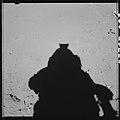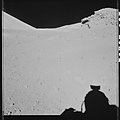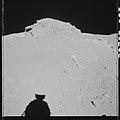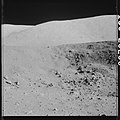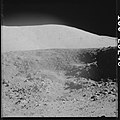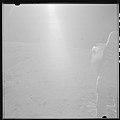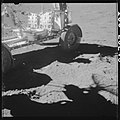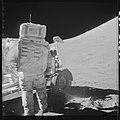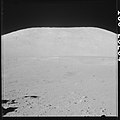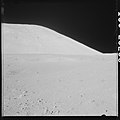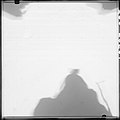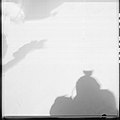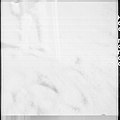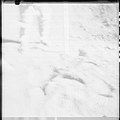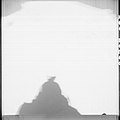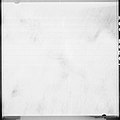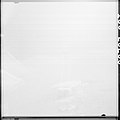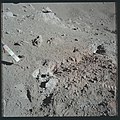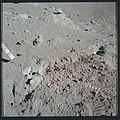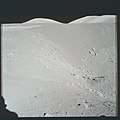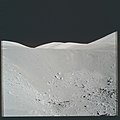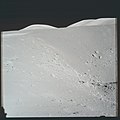Category:Apollo 17 EVA at Station 4
From the Apollo 17 Preliminary Science Report, Chapter 5 (NASA SP-330, 1973):
Shorty Crater (Station 4)
One of the premission alternatives around which our exploration was planned was the possibility that the 110-m-diameter crater Shorty was a volcanic vent. Although its general morphological appearance is that of a dark-rayed impact crater that had penetrated the light mantle, Shorty Crater held out the possibility of young volcanism. Other than Shorty, possible sources for the potential pyroclastic deposits of the dark floor material were difficult to delineate. The observations and sampling at Shorty Crater did not reveal directly what we had expected; however, the results of the investigation may yield equally important information from unexpected directions.
All the now classic difficulties in conducting geological operations on the surface of the Moon faced us at Shorty Crater. To begin with, we had made earlier decisions to spend extra time at previous localities without knowing what awaited us. Our oxygen supply limited the time we could spend at Shorty Crater to a clearly nonnegotiable 35 min. The normal "housekeeping" duties of dusting and reading the gravimeter demanded their usual but necessary due. Then, in addition to the usual complexities of lunar impact geology, an unexpected discovery appeared.
Shorty Crater has features consistent with an impact origin, although no one feature is conclusive in itself. Subfloor basalt appears to dominate the few blocks at the rim (AS17-137-21009). One of these blocks is pervasively fractured and may be shocked. The crater wall is locally blocky and has several radial and transverse changes in texture and albedo. There is no continuous bench in the crater wall; however, several well-defined lobes of coarse and fine debris, similar to those in the walls, extend out onto the floor and may be the relics of such a bench (AS17-137-20995). The blocky materials on the flat floor appeared to be highly fractured but otherwise uniform in texture. Parallel fracture organization is strong in some blocks.
The unexpected discovery at Shorty Crater was the presence of at least three deposits of very-finegrained orange soil (AS17-137-20990). There were also numerous indications of fine-grained black soil, which, together with the orange soil, was subsequently determined to be composed almost entirely of glass beads or devitrified glass beads of uniform composition. Two of the orange soil deposits are near the rim crest of the crater, whereas the other deposit is exposed on the western wall. In appearance, the deposits have many of the characteristics of fumarolic alteration halos; with this hope, we conducted our observation and sampling activities.
One deposit of orange soil was trenched across its trend along the crater rim. At this location, it was sampled in detail and the following relationships were observed:
1. The deposit is approximately 1 by 4 m in size at the surface and is elongate parallel to the rim crest.
2. The deposit has no topographic relief relative to other rim surfaces. (This is also true for the other rim deposit.)
3. Dark-gray surface material forms an approximately 0.5-cm.thick surface layer over both the deposit and the surrounding light-gray materials. There is an orange tint to this surface material directly over the deposit.
4. The contact of the deposit with light-gray debris on either side is irregular in detail but essentially vertical to a depth of at least 20 cm.
5. From the vertical contacts inward, the deposit grades from a yellowish orange over a distance of approximately 10 or 15 cm to a reddish orange.
6. The reddish-orange inner portion of the deposit is moderately coherent and is crossed by at least two apparent joint sets.
7. During the postmission unpacking of a sample from the reddish-orange zone, a clod was observed that was sharply and concentrically zoned inward from orange brown-gray to bluish gray.
8. Examinations of the outer surface of the core tube drawn from the deposit showed that the orange glass changes sharply to a black material at a depth of approximately 25 cm. The black material extends to a depth of at least 70 cm.
One can conceive of many samples and observations left uncollected at this remarkable locality. However, few of our experiences in the Apollo Program better illustrate the inherent quality of scientific investigation that is possible from the integrated effort of so many in so short a time.
Media in category "Apollo 17 EVA at Station 4"
The following 89 files are in this category, out of 89 total.
-
A17 PSR Fig 6-59 Shorty Crater cross section.jpg 531 × 165; 31 KB
-
A17 PSR Figure 6-111 Station 4.gif 334 × 201; 7 KB
-
AS17-133-20229 (21653452312).jpg 4,175 × 4,175; 4.46 MB
-
AS17-133-20230 (21043848413).jpg 4,175 × 4,175; 4.65 MB
-
AS17-133-20231 (21477000348).jpg 4,175 × 4,175; 4.59 MB
-
AS17-133-20232 (21476924160).jpg 4,175 × 4,175; 4.6 MB
-
AS17-133-20233 (21674010041).jpg 4,175 × 4,175; 4.58 MB
-
AS17-133-20234 (21476922300).jpg 4,175 × 4,175; 4.69 MB
-
AS17-133-20235 (21664815155).jpg 4,175 × 4,175; 4.61 MB
-
AS17-133-20236 (21042171414).jpg 4,175 × 4,175; 4.78 MB
-
AS17-133-20237 (21653444212).jpg 4,175 × 4,175; 4.85 MB
-
AS17-133-20238 (21664811755).jpg 4,175 × 4,175; 4.76 MB
-
AS17-133-20239 (21653442422).jpg 4,175 × 4,175; 4.9 MB
-
AS17-133-20240 (21476915940).jpg 4,175 × 4,175; 4.86 MB
-
AS17-133-20241 (21674001451).jpg 4,175 × 4,175; 4.53 MB
-
AS17-133-20242 (21664807525).jpg 4,175 × 4,175; 4.63 MB
-
AS17-133-20243 (21043834903).jpg 4,175 × 4,175; 4.74 MB
-
AS17-133-20244 (21476987168).jpg 4,175 × 4,175; 4.8 MB
-
AS17-133-20245 (21476910680).jpg 4,175 × 4,175; 4.69 MB
-
AS17-133-20246 (21638767866).jpg 4,175 × 4,175; 4.88 MB
-
AS17-133-20247 (21043830793).jpg 4,175 × 4,175; 4.45 MB
-
AS17-133-20248 (21673994311).jpg 4,175 × 4,175; 4.57 MB
-
AS17-133-20249 (21476906670).jpg 4,175 × 4,175; 4.37 MB
-
AS17-133-20250 (21476905640).jpg 4,175 × 4,175; 4.38 MB
-
AS17-133-20251 (21476904670).jpg 4,175 × 4,175; 4.7 MB
-
AS17-133-20252 (21653429262).jpg 4,175 × 4,175; 4.53 MB
-
AS17-133-20253 (21664796665).jpg 4,175 × 4,175; 4.63 MB
-
AS17-133-20254 (21043824343).jpg 4,175 × 4,175; 4.65 MB
-
AS17-133-20255 (21638759156).jpg 4,175 × 4,175; 4.7 MB
-
AS17-133-20256 (21653425572).jpg 4,175 × 4,175; 4.56 MB
-
AS17-133-20257 (21476898510).jpg 4,175 × 4,175; 6.04 MB
-
AS17-133-20258 (21476972458).jpg 4,175 × 4,175; 6.12 MB
-
AS17-133-20259 (21653421842).jpg 4,175 × 4,175; 6.21 MB
-
AS17-133-20260 (21653301542).jpg 4,175 × 4,175; 6.98 MB
-
AS17-133-20261 (21476894830).jpg 4,175 × 4,175; 6.61 MB
-
AS17-133-20262 (21653419192).jpg 4,175 × 4,175; 6.52 MB
-
AS17-133-20263 (21476891650).jpg 4,175 × 4,175; 6.46 MB
-
AS17-133-20264 (21638748796).jpg 4,175 × 4,175; 6.49 MB
-
AS17-133-20265 (21476963868).jpg 4,175 × 4,175; 6.6 MB
-
AS17-133-20266 (21042139234).jpg 4,175 × 4,175; 6.48 MB
-
AS17-133-20267 (21638744066).jpg 4,175 × 4,175; 6.87 MB
-
AS17-133-20268 (21653409922).jpg 4,175 × 4,175; 6.84 MB
-
AS17-137-20984 (21497553359).jpg 4,175 × 4,175; 6.03 MB
-
AS17-137-20985 (21693575121).jpg 4,175 × 4,175; 6.69 MB
-
AS17-137-20986 (21497553029).jpg 4,175 × 4,175; 6.49 MB
-
AS17-137-20987 (21693574701).jpg 4,175 × 4,175; 6.59 MB
-
AS17-137-20988 (21684372275).jpg 4,175 × 4,175; 6.31 MB
-
AS17-137-20989 (21063387513).jpg 4,175 × 4,175; 7.09 MB
-
AS17-137-20990 (21672948392).jpg 4,175 × 4,175; 7 MB
-
AS17-137-20991 (21063387213).jpg 4,175 × 4,175; 8.69 MB
-
AS17-137-20992 (21658309636).jpg 4,175 × 4,175; 8.15 MB
-
AS17-137-20993 (21684371305).jpg 4,175 × 4,175; 7.56 MB
-
AS17-137-20994 (21061681824).jpg 4,175 × 4,175; 6.6 MB
-
AS17-137-20995 (21497551719).jpg 4,175 × 4,175; 6.18 MB
-
AS17-137-20996 (21684370985).jpg 4,175 × 4,175; 6.05 MB
-
AS17-137-20997 (21672947212).jpg 4,175 × 4,175; 6.38 MB
-
AS17-137-20998 (21496442610).jpg 4,175 × 4,175; 6.5 MB
-
AS17-137-20999 (21063385673).jpg 4,175 × 4,175; 8.07 MB
-
AS17-137-21000 (21061690634).jpg 4,175 × 4,175; 8.2 MB
-
AS17-137-21001 (21693572011).jpg 4,175 × 4,175; 8.67 MB
-
AS17-137-21002 (21061681344).jpg 4,175 × 4,175; 8.77 MB
-
AS17-137-21003 (21497550109).jpg 4,175 × 4,175; 9.01 MB
-
AS17-137-21004 (21497549929).jpg 4,175 × 4,175; 9.42 MB
-
AS17-137-21005 (21672945482).jpg 4,175 × 4,175; 6.9 MB
-
AS17-137-21006 (21061689274).jpg 4,175 × 4,175; 8.97 MB
-
AS17-137-21007 (21496537348).jpg 4,175 × 4,175; 8.28 MB
-
AS17-137-21008 (21063383373).jpg 4,175 × 4,175; 6.95 MB
-
AS17-137-21009 (21496440140).jpg 4,175 × 4,175; 7.78 MB
-
AS17-137-21010 (21693570381).jpg 4,175 × 4,175; 7.77 MB
-
AS17-137-21011 (21063382563).jpg 4,175 × 4,175; 7.8 MB
-
AS17-137-21012 (21496433040).jpg 4,175 × 4,175; 7.2 MB
-
AS17-137-21013 (21063382373).jpg 4,175 × 4,175; 7.61 MB
-
AS17-137-21014 (21693569701).jpg 4,175 × 4,175; 6.81 MB
-
AS17-137-21015 (21672943532).jpg 4,175 × 4,175; 6.74 MB
-
AS17-137-21016 (21684366825).jpg 4,175 × 4,175; 7.25 MB
-
AS17-137-21017 (21658304866).jpg 4,175 × 4,175; 8.4 MB
-
AS17-137-21018 (21658298346).jpg 4,175 × 4,175; 7.41 MB
-
AS17-137-21019 (21497546959).jpg 4,175 × 4,175; 6.35 MB
-
AS17-137-21020 (21693568581).jpg 4,175 × 4,175; 5.76 MB
-
AS17-137-21021 (21684365825).jpg 4,175 × 4,175; 4.76 MB
-
AS17-137-21022 (21658304016).jpg 4,175 × 4,175; 4.54 MB
-
AS17-137-21023 (21658303786).jpg 4,175 × 4,175; 6.09 MB
-
AS17-137-21024 (21496529198).jpg 4,175 × 4,175; 6.8 MB
-
AS17-137-21025 (21693567781).jpg 4,175 × 4,175; 6.42 MB
-
AS17-137-21026 (21684365085).jpg 4,175 × 4,175; 6.77 MB
-
AS17-137-21027 (21061685284).jpg 4,175 × 4,175; 4.78 MB
-
Lunarama - GPN-2000-001149.jpg 3,011 × 3,000; 5.99 MB
-
Shorty crater AS17-P-2750 ASU.jpg 240 × 240; 13 KB
-
Shorty crater location AS17-151-23251.jpg 296 × 290; 48 KB

